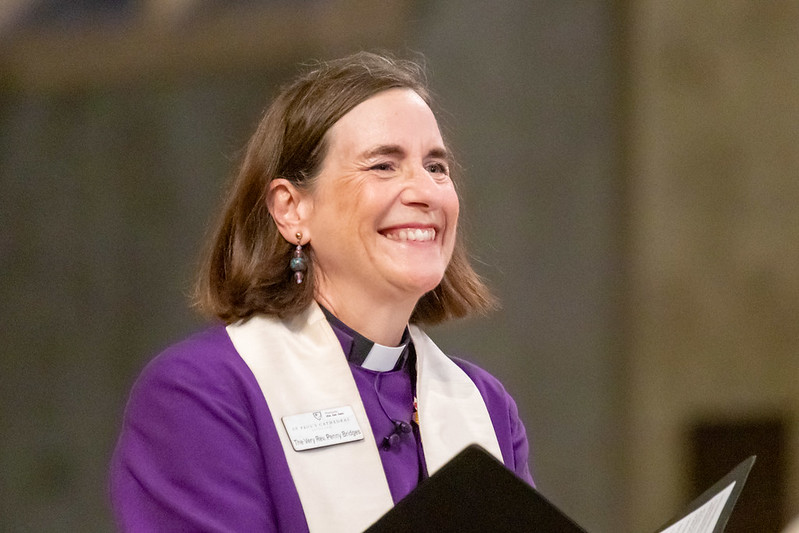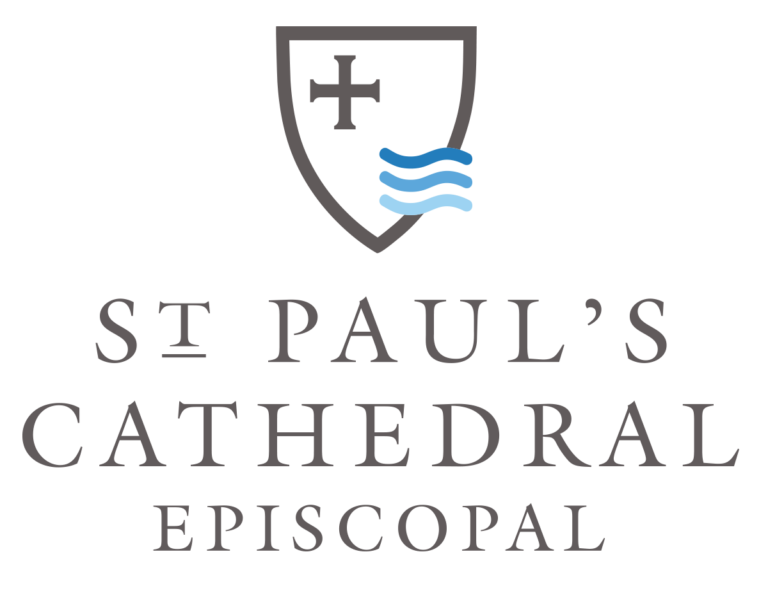
April 23, 2023 The Third Sunday of Easter
Penelope Bridges
Alleluia, Christ is risen. The Lord is risen indeed, Alleluia.
Today is a tangle of themes and emotions. It’s Easter season: we rejoice to know ourselves redeemed and forgiven. It’s Creation Care Sunday at St. Paul’s: we acknowledge our sinful abuse of the earth and its resources, and encourage one another to do better, to consume less, to work for justice and exercise responsible stewardship. Today’s Gospel focuses our attention on our experience of Christ in the sacrament of Communion. And it’s my last Sunday before I step away from you for ten weeks.
How do we honor all of this in an orderly fashion?
Let’s start where today’s Gospel starts: two people walking from Jerusalem to Emmaus on a dusty road on a beautiful spring evening. Our story begins, “Two of them”. Two of whom? Two of the group of disciples who, earlier that day, had scoffed at the women’s wild tale of an empty tomb and an angel’s message of resurrection. Two people who, although it was Easter Day, were not yet Easter people.
Bring to mind your experience of walking: I think about walking the Stations of the Suffering through our city on good Friday. Walking the labyrinth in the Dean’s Courtyard. Walking around Bankers Hill with our evangelism ministers to share good news. Walking from Hillcrest to St. Paul’s in the Pride parade.
I’ve noticed that, when I walk a route that I usually drive, I pay far more attention to my surroundings. I notice the ups and downs of the road; the details on the houses; the trees and flowers on either side. I feel closer to the earth, both literally and spiritually. Walking doesn’t require much concentration, and I have the time to look around and give thanks for the beauty of creation as it unfolds before my eyes.
But for these two disciples, Cleopas and his partner on that Easter evening, it wasn’t a pleasant stroll: they were returning home defeated and devastated. They were probably too deep in grief to appreciate the beauty that surrounded them. They were even too preoccupied to notice a stranger coming up behind them until he spoke to them. And even then, they did not recognize him.
How can that be? They don’t recognize the very man whose death they are mourning. Why is it that the risen Jesus seems to play games with his followers, hiding his identity and pretending not to know what’s been happening? For me, this is the central mystery of the story. According to Archbishop Rowan Williams, Jesus is unrecognizable because he is risen: he has passed to a kind of existence that we cannot understand. He has been transformed. The risen Jesus is elusive, impossible to hold onto; he comes and goes without announcement; we cannot wrap our minds around him.
This is as it should be. As the second person of the Trinity his presence should be mysterious for us: he remains defiantly alien, other. And this opens us up to the realization that he may be encountered in anyone who seems alien and other. And so we are compelled to approach the stranger as if they were Christ, in compassion and welcome. As Williams writes, “To let the other be strange and yet not reject him or her, to give and be given attentive, contemplative regard – this is all part of our encounter with a risen Lord.” (Rowan Williams, Resurrection: interpreting the Easter Gospel. 1982, Cleveland: the Pilgrim Press).
The post-Easter Jesus is not the meek, suffering servant of the Passion story. This is a supernatural presence, one who is mortally wounded, and yet alive and filled with power. We have moved on from the horror and victimhood of Good Friday to a dynamic that is much harder to define, to a Jesus with whom we struggle to identify. This Easter relationship requires us to break out of old patterns of dependence and passivity, to claim our mature faith, to accept the strangeness of this Jesus, and move out into the world to share him with the world.
By being someone with whom we cannot completely identify, the risen Jesus opens our eyes to the rest of the world, to those who are hungry and oppressed, to the scars and wounds that the earth carries thanks to our sinful actions. He turns our attention to the rest of creation and awakens compassion in our hearts, along with the realization that we have a lot of work to do.
Archbishop Williams writes more about this mystery. When we gaze upon the wounded but risen Christ, he says, “the familiarity of his pain is not simply the familiarity of our own; it is the all too recognizable face of the world whose suffering we have helped to make … The Gospel will not ever tell us we are innocent, but it will tell us we are loved … Grace will remake but not undo. There is all the difference in the world between Christ uncrucified and Christ risen: they speak of two different kinds of hope for humanity, one unrealizable, the other barely imaginable but at least truthful.” (Williams: Resurrection)
As the two disciples share their story, this mysterious stranger hears how it ends – with disappointment and loss: “We had hoped that he was the one who would redeem Israel; but …”. He hears their pain, and in a gentle reproof of Cleopas’ hope, he corrects their limited vision: he isn’t only the one who would redeem Israel, because that is far too restricted a mission. He is the one to redeem all of Creation, as the totality of Scripture that he unfolds makes clear.
And, as the story continues, the hospitable action of the two disciples, inviting the stranger into their home, leads to the sacredness of the table, where he reveals himself to them in the breaking of the bread, and transforms their sadness and exhaustion into joyful life and energy.
The pattern of this Gospel story is the pattern of a life of faith – a journey in community, sharing our stories and our sadness over all that is broken in the world. Scripture recounted and reflected upon. The sacred meal in which the risen Christ is made known to us, and hope is reborn. The new energy and sharing of the good news with the world, before the cycle repeats as our journey continues.
The risen Christ is made known to us in the breaking of the bread. We can know him only through the Eucharist, as the source of our post-Easter life. These two disciples show us how to be in relationship with Jesus after Easter. When we come together to worship, we won’t just tell stories of something that happened long ago: we will encounter him ourselves in the moment of sacramental participation. The body of Christ, the blood of Christ, the token of our Easter life in him.
Luke’s story, like other post-resurrection stories in the New Testament, reinforces the message that the risen Christ inhabited a physical body, even if he was able to appear and disappear at will. This solid physicality is a fundamental part of the Easter message, in every detail. The grim reality of his wounds, the narrative that takes us down a dusty road to a home where ordinary food becomes the vehicle of the sacred; the race back to the city to tell the gathered community of their experience: it’s all very grounded. Think of those walks we have taken, our feet on the earth.
Each of the post-resurrection appearances features food, which comes from the abundance of nature. Bread is almost universally the basic food, formed from the fruits of the earth; and in this Emmaus story, it’s a loaf of bread that he takes and blesses. Later in this chapter, when Jesus shows up after Cleopas and his companion have told their story to the other disciples, Jesus asks for something to eat and is given a piece of fish, fruit of the sea. In the last chapter of John’s Gospel we hear the story of a lakeside breakfast of bread and fish. The abundance of earth and ocean is central to the good news, and on this Creation Care Sunday we give thanks for all that the earth gives us. We are part of the Creation and our lives depend on that continued abundance.
The Eucharist that we celebrate is based around the simple foods of bread and wine. This symbolic meal brings us together as one body, and it holds us together even when we are far apart. During the lockdown many of us found the lack of the Eucharist especially painful, and it was a very special day when we were able, finally, to share Communion together once more. It is the central ritual of our faith and a profound source of joy in its multiple meanings: spiritual nourishment, participation in Jesus, strengthening of community, promise of eternal life, symbol of hope, blessing of the earth’s produce.
On Wednesday I will embark on my sabbatical leave. I don’t know how often I will receive Communion while I am away, and it’s unlikely that I will get to be the celebrant. I will miss that privilege, which has been a weekly mainstay of my life for over 25 years. I will be fasting, in a sense, from something that feeds my soul. My return to you in July will be especially meaningful as I once again experience the great blessing of presiding at this altar with this community. As ready as I am for the respite of a sabbatical leave, I will return as eagerly as those two disciples returned to Jerusalem after their encounter with the risen Christ, and I look forward to sharing the good news in the light of my experiences away from here.
And that’s the final lesson of the Emmaus Gospel: the good news is always to be shared with others, through preaching, through service, through compassion and forgiveness. Our baptismal promise calls us to proclaim by word and example the good news of God in Christ. At the end of this Gospel story the disciples are Easter people, restored by their encounters with the risen Christ. We are the heirs of their joy and their mission. Like them, we are witnesses, and god sends us out to bear witness to the message of new life and new creation that is the message of Easter.
Alleluia, Christ is risen. The Lord is risen indeed, Alleluia.

